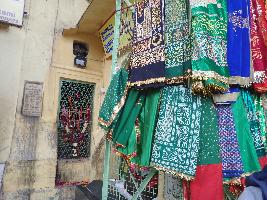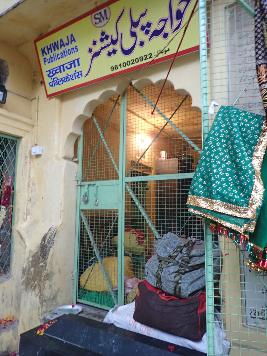

.jpeg)


.jpeg)

The Dalan of Mirza Akram is a historical structure located in Shahjahanabad (Old Delhi), which holds significant historical and architectural value. The dalan (hall) is believed to contain the grave of Ikram Khan, a Mirdha (non-commissioned officer) who served during the reign of Shah Alam II (1759-1806), a period marked by the decline of Mughal power and increasing influence of the British East India Company. The site also has connections to Ziyuaddin Barm, the author of Tarikhi Firoz Shahi, a famous historical text, who is said to be buried here as well. Architectural Description: Raised Plinth: The entire structure is built on an elevated plinth, a common feature in Mughal architecture designed to give prominence and a sense of grandeur to the building. Three Arched Entrances: The northern façade of the building features three prominent arched entrances, allowing access to the dalan. Twin-Fluted Columns: The arches are supported by beautifully crafted twin-fluted columns. Fluting refers to the vertical grooves carved into the columns, a design element reflecting the architectural style of the Mughal period. Graves: Inside the dalan, there are four graves, which belong to Mirdha Ikram Khan and his family. These graves likely reflect the traditional Mughal style of tomb construction, with a simple, rectangular layout adorned with Islamic inscriptions. Historical Significance: Ikram Khan: As a Mirdha, Ikram Khan held a non-commissioned officer's rank, likely playing an administrative or military role during the turbulent period of Shah Alam II's reign. His grave within the dalan underscores his status and significance in Mughal society. Ziyuaddin Barm: The possible presence of Ziyuaddin Barm, the author of Tarikhi Firoz Shahi, adds literary and historical importance to the site. His work, documenting the history of Sultan Firoz Shah Tughlaq and his era, is a valuable source for understanding medieval Indian history. Establishment: The Dalan of Mirza Akram would have been established during the late 18th or early 19th century, possibly during Shah Alam II’s reign or soon after, given its association with a Mughal officer of that period. The building reflects the architectural preferences of late Mughal architecture, marked by simpler forms but still retaining the elegance of arched doorways, fluted columns, and raised platforms. It was likely constructed as a private space for the family, later serving as their burial site. While the structure has historical and architectural merit, it, like many heritage buildings in Old Delhi, likely faces challenges of neglect and the pressures of urbanization. Preservation efforts would be essential to protect its historical legacy and ensure the stories of figures like Ikram Khan and Ziyuaddin Barm are not lost to time.